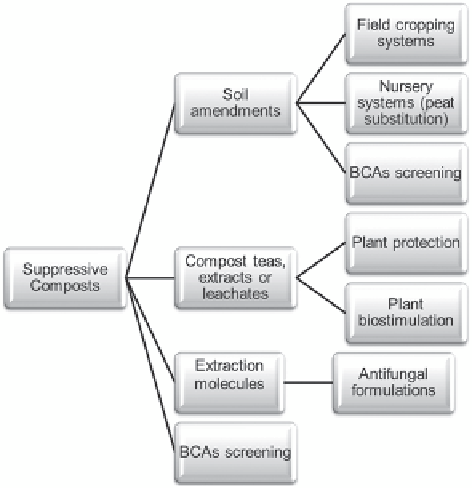Agriculture Reference
In-Depth Information
Fig. 8.4
Tree of resource that
can be derived from suppres-
sive composts exploitation
and their applications
Useful bio-control agents can be isolated from rhizospheric soil treated whit sup-
pressive composts. It is the case, for example, of some root-associated microbes of
the genera
Bacillus
,
Lysinibacillus
,
Enterobacter
and
Serratia
, selected for their
suppressivity to tomato crown and root rot disease caused by
F. oxysporum
f. sp.
radicis-lycopersici
(Kavroulakis et al.
2010
). While, Pane et al. (
2012a
) showed
a selective stepwise procedure that allowed to get
Bacillus methylotrophicus
and
Bacillus amyloliquefaciens
strains able to control
S. minor
,
R. solani
and
F. solani
from composts and compost amended soils.
8.6.2
Compost-derived Natural Substances
Nutrients and organic molecules, such as humic substances and phytochemicals ex-
tracted from composts, can prove valuable in limiting the detrimental effects of
pathogens on plants. Organic substrates deriving humic acid fractions (HAs) has
been characterized for the In-vitro suppression of fungal pathogens and the In-vivo
protection of China aster infected with
F. oxysporum
f. sp.
callistephi
and impatiens
infected with
P. ultimum
(Loffredo and Senesi
2009
). In this case, however, the
mechanisms of action are not completely understood. Nevertheless, recent studies
showed the significant correlation between chemical and structural properties of the
functional groups of these substances, such as total acidity, COOH group content
and elemental composition, and their capability to inhibit fungal phytopathogens
(Moliszewska and Pisarek
1996
; Loffredo and Senesi
2009
). Humic compounds
derived from a prolonged biological degradation of organic matter are organized

